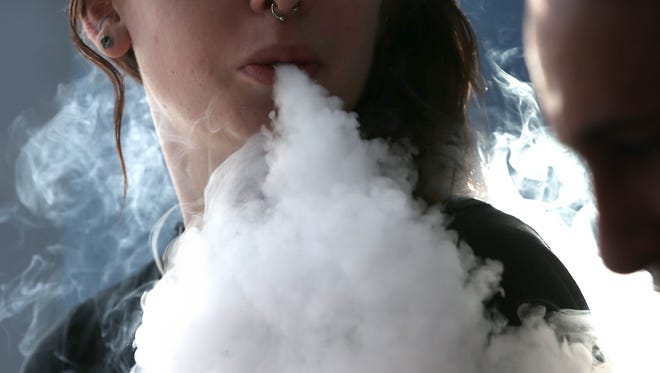More teens now try vaping than smoking
Trying conventional cigarettes is no longer a teen rite of passage, but trying e-cigarettes might be becoming one, a new government survey suggests.
Nearly half of high school students surveyed in 2015 tried vaping, while only a third smoked a tobacco cigarette, according to the nationwide survey of 15,000 students released Thursday by the federal Centers for Disease Control and Prevention.
The number of students who reported taking even one puff of a tobacco cigarette dropped from 70% in the early 1990s to 41% in 2013 and 32% in 2015. But 45% of the students in the 2015 survey had tried vaping – inhaling nicotine-infused water vapor from e-cigarettes, pipes, pens, hookahs and other devices.

Fewer were regular smokers or vapers: 11% had smoked tobacco cigarettes in the 30 days before the survey, down from 16% in 2013; 24% had vaped. It was the first time CDC included e-cigarette use in the long-running Youth Risk Behavior Survey. But another government survey on teen smoking, released in April, found smoking numbers fell while vaping numbers rose between 2011 and 2015.
What remains unknown are the health effects of this shift – including whether teens who use e-cigarettes are more or less likely to eventually become tobacco smokers. There’s also concern about the direct effects of inhaling nicotine and other ingredients in vaping products.
"We don’t’ know the long term impact, and yet there's a lot of messaging saying this is s safe alternative," said Amy Lukowski, a psychologist specializing in smoking cessation at National Jewish Health in Denver. The potential effect of nicotine on young brains is especially worrisome, she said.
The devices "offer one more pathway to addiction," said David Dobbins, chief operating officer of Truth Initiative, a non-profit advocacy group fighting tobacco use and critical of e-cigarette marketing to youths.
The growth in vaping occurred during a period in which the products were largely unregulated. But that is changing. In May, the FDA announced new rules that will outlaw e-cigarette sales to minors.
Industry groups, including the Smoke-Free Alternatives Trade Association and the International Vapor Association, support the ban on sales to minors, while opposing other parts of the new rules. They say e-cigarettes are safer alternatives for adult smokers.
Regulators and educators also continue to fight youth tobacco use. On Thursday, California became the second state, after Hawaii, to outlaw all tobacco sales to people under age 21.
Smoking remains the leading preventable cause of death in the United States, killing 480,000 people each year, according to The Campaign for Tobacco Free Kids.
The decline in smoking is just one piece of good news in the CDC youth report. It also shows long term declines in teen sexual activity, physical fighting and alcohol use. On the other hand, condom use and HIV testing are in decline, while rates of bullying and texting while driving held steady, said Stephanie Zaza, a CDC official who presented the data during a telephone press conference.
"We are encouraged that high school students are making some better choices," she said. "We still have progress to make."